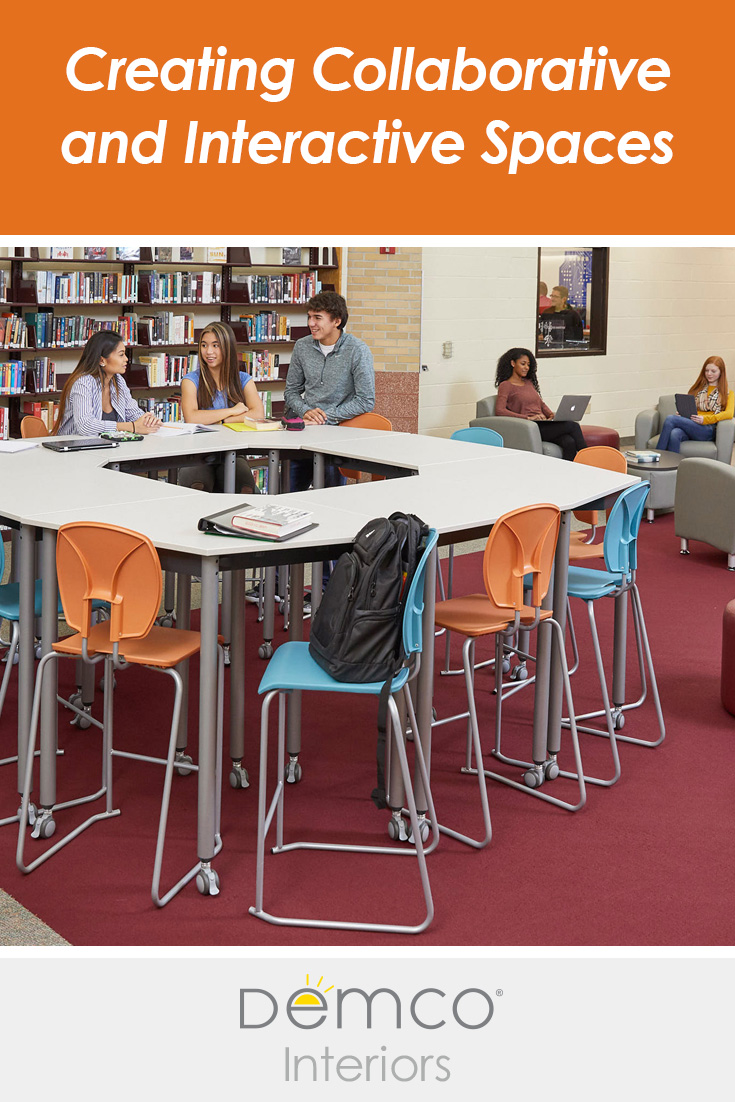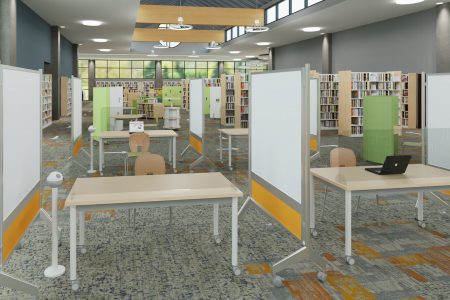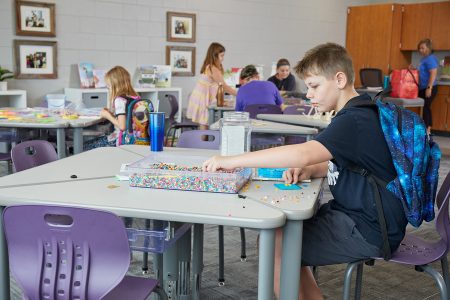Modern school libraries are no longer solely quiet havens of individual study. They now support a wide variety of learning styles and activities. One of those key types of learning is collaboration, where multiple students are working together on a project or idea. Another type of learning is interactive, where students can interact with or manipulate the space in some way. We see this a great deal in makerspaces, but there’s also something to be said for stand-alone, self-guided interactive spaces as well. Here are some ways you can incorporate these types of spaces into your library.
Low-Tech Collaboration Support
 Not every change to your space has to be shiny and high tech. There are a lot of simple low-tech changes that can make a big difference in your space. Several of these can be free or budget friendly, but if you’ve got funding available to spend, there are definitely items out there that can help. Try these ideas.
Not every change to your space has to be shiny and high tech. There are a lot of simple low-tech changes that can make a big difference in your space. Several of these can be free or budget friendly, but if you’ve got funding available to spend, there are definitely items out there that can help. Try these ideas.
Change Up Your Furniture
Even though older furniture can be heavy to move, you don’t have to leave all the tables separate with only four chairs to a table. There may be instances where that’s required, but most of the time, you can rearrange how your furniture is laid out and end up with new learning opportunities. Try grouping together two rectangular tables on the long side to create a large square for eight students. Or line them up on the short side to create one longer table. If you have some open space along the walls, think about moving a table or two there. Having a wall to one side of you helps to give small groups a sense of privacy and can boost collaboration.
If you’re looking to purchase new furniture, consider factors like flexibility, mobility, and variety. Look for different heights and different fabrics. Consider items that have some built-in privacy to support collaboration, like diner booths or movable screens. And remember, the number of students collaborating can vary. Think about having furniture to support small groups of two to three students as well as larger surfaces for large-group projects. There are a ton of amazing options out there that allow you to completely reconfigure your learning space quickly and easily. Explore more flexible furniture in the following idea galleries:
- Collaboration Solutions Idea Gallery
- Flexible Seating Idea Gallery
- Library Furniture for Multifunctional Spaces Idea Gallery
- 21st Century Learning Environment Idea Gallery
- Library as Learning Commons Idea Gallery
Whiteboards and Writeable Surfaces
Surfaces that allow students to write, draw, and brainstorm can provide powerful collaboration support and give students a fun way to interact with the space. These could be wall-mounted whiteboards, mobile whiteboards, dry-erase tables, or whiteboard or chalkboard painted surfaces. For more budget-friendly options (a great way to prototype an idea and get support for funding more expensive projects), consider starting out with whiteboard contact paper or shower board. Don’t forget to look to other places in your school for things you can move or repurpose. For example, we had a wall-mounted whiteboard in a copy room at my previous school that was never used. We had it moved into the library and mounted a projector above it to create a presentation space.
For more about the benefits of writable surfaces, check out “3 Reasons Why You Need Whiteboards in Your Library or Classroom.”

Conversation Zone Signage
By rearranging and reimagining our spaces, we can honor the learning styles of all our students. Some students need places to talk to each other and collaborate. Others need quiet areas to do focused work. Create some signage indicating different conversation zone areas to help support your students, especially those who need quiet study. Think about the way that sound travels in your space and the natural areas that groups tend to congregate in and work from there. A library space that supports collaboration can sometimes get pretty loud. You want to make sure that there are still those quiet caves available when students need them.
Hands-On Interactive Spaces
Children’s and science museums have long known that there is a power in creating hands-on, interactive spaces that allow visitors to manipulate their environment. These types of interactive spaces can be a fantastic addition to our libraries. Consider different ways you can add places, stations, and activities that allow your students to interact with and change the space. Writable surfaces and mobile furniture are two ways to allow students to manipulate the space. But don’t be afraid to think beyond that. Here are a few examples:
- Create a Lego® wall
- Display magnetic poetry and encourage students to create their own poems and take a photo of them. Add photos of poems to a display during Poetry Month or any time of year.
- Create bulletin boards that prompt interaction, such as student book recommendations written on Post-it® notes and informal surveys.
- Display StickTogether® posters and encourage students to add to them during downtime or use them as incentives.
High-Tech Collaboration Support
Technology often plays a role in group work and collaboration in our schools. Whether you’re 1:1, BYOD, or somewhere in between, your students are likely using technology for collaboration at some point in your library. By creating a few changes within your space, you can do more to support technology use. These changes are generally more expensive than some of the low-tech ones, but they work well with grants or PTSA donations since they have a big impact.
 Teaming Tables
Teaming Tables
A teaming table, or media table, is a table that includes a monitor and cables which allow you to display a device on a larger screen. There are plenty of variations out there: tables with multiple screens, cables for a variety of devices, charging ports built in, etc. Some of these can be quite expensive, but it’s also possible to DIY or adapt a simpler table with a flat-screen monitor that you already have. The main point is to create a space that supports collaboration on devices. If you’ve ever seen several students hovered over an iPad® trying to edit a group presentation, you know that it’s hard to collaborate on such a small screen. Mobile devices are geared towards individual users rather than groups. By incorporating a teaming table into your space, you help collaboration on mobile devices to flow much more smoothly.
Charging Stations

Devices are a part of our students’ lives. No matter what grade level, it’s likely that you have students with devices that need to get charged throughout the day. Unfortunately, many of our libraries were not designed with access to power in mind, so you might have to get creative. I’ve found outlets hidden underneath or behind stacks. I’ve had floor outlets in odd places left over from a previous computer lab. Look for hidden outlets and rearrange to free them up and find out if it’s possible to have your school or district relocate an outlet to a better position or put in new ones.
Observe safety rules and don’t run extension cords through walkways or create fire hazards. Read more about safety precautions in “4 Mistakes You Don’t Want to Make When Redesigning Your Learning Space.” One thing you can consider to support devices is to add power strips with USB ports in them throughout your space. Or have facilities change out your outlet covers to ones that have USB ports built in. Think about making charging cables available for checkout, or do like Librarian Gwyneth Jones and check out portable chargers to students.
There are more expensive charging options out there that can be great solutions. There are stand-alone charging stations that you can leave your device charging on. There are lockable charging lockers. There are also mobile and flexible systems like Bretford® Juice™ Pods and Floor System. Take your time thinking about students’ device habits, your school environment, and what solution might work best for you. Is theft an issue at your school? Open options probably aren’t your best bet. Is your furniture constantly being reconfigured? A flexible option might work better.
Prototype first, start small, and then evaluate how things are going. That’ll give you a better idea as to whether or not you should fundraise or seek grants to get that charging station and which one might be the best option for your school.
Make the Space Available and Students Will Use It
Our students want to collaborate with each other. They will find a space and time to work together whether or not we provide it for them. By creating interactive spaces within the library and providing a few tools and an environment that supports them, we can help to facilitate that collaboration. We can draw students into the library and help them continue to see it as a vital learning space and resource within their school.
Diana Rendina
Latest posts by Diana Rendina (see all)
- Creating Collaborative and Interactive Spaces in Your Library - June 24, 2019





August 12, 2020 @ 1:53 pm
We are a public library. How can we help our patrons with their searches on the computers, (how to file for unemployment …), while staying 6 feet apart?
We don’t want to use laser pointers.
August 17, 2020 @ 11:48 am
Hi, Janet,
Many libraries are using remote connection software to connect to the user’s computer remotely to help guide them.
Best,
Liz